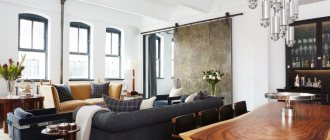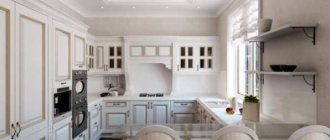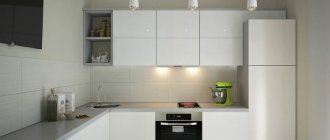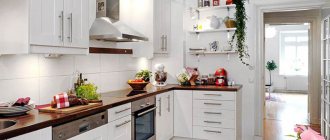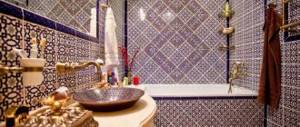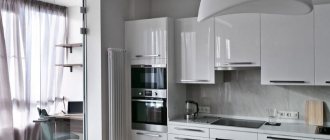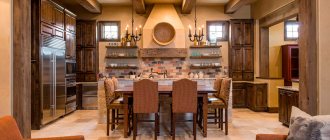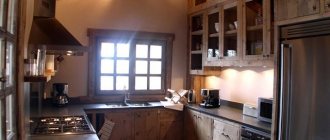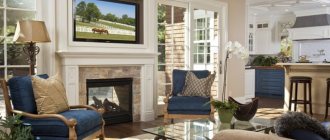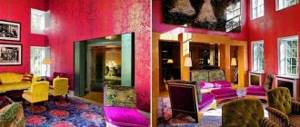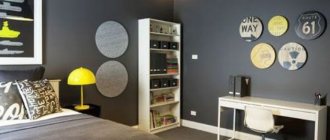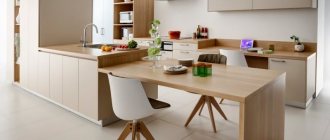Quite a lot of people like the cozy, but at the same time laconic Mediterranean style. It is one of the varieties of the popular Provence style, but it has a number of its own distinctive features, which allows it to be placed in a separate category. The Mediterranean style has absorbed the traditions of several countries at once - France, Italy, Spain, Greece.
Mediterranean style kitchens look very cozy and stylish.
Thus, the freedom of design imagination becomes much wider, and the possibilities for designing a kitchen appear many times more. In this article we will take a detailed look at all the features of the Mediterranean style and give tips on how to make your kitchen truly cozy and beautiful.
The style is very liberal, but it is still worth following the rules.
General design trends
Like any other style, Mediterranean has its own traditions, which should be strictly adhered to. However, it is much freer than the classical types of design, for many of which the rules are unshakable - here you can allow various variations.
Mediterranean-style kitchens can be very diverse.
Let's take a closer look at what features are inherent in the Mediterranean style:
- Most Mediterranean countries adhere to laconicism in the interior. Therefore, you will have to abandon complex, overly elaborate materials and furniture. Give preference to simple lines and textures - with the right combination, they look much more advantageous than complex ones.
- You can compensate for the simplicity with a rich color palette: you are free to use almost any natural shades found in nature and combine them in any way you like. We will tell you more about the colors of a Mediterranean-style kitchen below.
- Finishing materials must be natural or qualitatively imitate natural ones: stone, wood, fabrics, leather, metals. Avoid plastic and lots of glass - they are not typical for the Mediterranean style.
- Remember that the main principle is the combination of beauty with practicality. This means that in such a kitchen there is no place for various decorations that simply take up space: any decor should also have a practical function.
As you can see, nothing is complicated: such rules leave a huge scope for imagination. Now let's move on to more specific recommendations.
The main thing is to find those features that appeal to you.
Features of the Mediterranean style
The Mediterranean style combines the traditions and culture of the peoples of Greece, Spain, Turkey, Italy and other countries of the Mediterranean basin. Its name captures the main idea of the idea: lightness and freshness.
Among the main features of this design concept are the following features:
- the interior should contain indoor plants;
- ceramic dishes, tiles and decorations are an integral part of the Mediterranean style;
- ceiling wooden beams are allowed;
- for the functional and ergonomic organization of space in the kitchen, an “island” arrangement of objects and furniture is often used;
- every corner in the room should be illuminated;
- the dining table can accommodate at least 6-7 people;
- all items that are in the room should be used and not just lying around for decoration;
- the presence of large windows, since natural light plays an important role in this direction;
- The interior is characterized by the use of natural materials: ceramics, stone, wood;
- the presence of light curtains made of flowing fabric;
- the presence of high ceilings, large arches and niches;
- the interior is rich in handmade elements;
- In order to avoid variegation, more than 3 colors should not be used in the decoration of the room.
In many Mediterranean-style country houses, living rooms, dining rooms and kitchens are not separated by a wall. This allows you not only to expand the space, but also to fill it with natural light and freshness.
You can see the Mediterranean style kitchen design in the photo:
Working with the floor
As we have already said, materials are of great importance - they should be predominantly natural. Most often, tiles or porcelain stoneware are used to finish the floor in the kitchen - they are hygienic, durable and not too expensive.
Sometimes a combined solution is allowed for different zones.
In addition, warm-colored marble is suitable. If a real marble floor seems too expensive for you, you can try to find a suitable imitation. However, the latter must be of high quality - this style does not tolerate outright fakes.
The floor is simply a backdrop to the kitchen, but that doesn’t mean it should be neglected.
Advice! Marble mosaic tiles on the floor are a real boon for a Mediterranean-style kitchen. However, remember that it should not be too pretentious.
A wooden floor also looks good. Choose warm, not too dark shades - the latter may look too heavy.
There are many options for floor design.
The most budget-friendly options can be considered laminate or linoleum - if you choose the right texture, the floor will fit into the interior of your kitchen.
By the way! Warm floors are the ideal solution for a Mediterranean-style kitchen. It will make it much warmer and more comfortable, which is quite consistent with the concept.
Finishing walls, floors and ceilings
To decorate the kitchen, simple, without a hint of luxury, high-quality natural materials are used. They provide an environmentally friendly environment, keep you cool on a hot day, and in winter make the room warmer and more comfortable.
Walls
Textured plaster would be an ideal material for walls. Unevenness and roughness of the surface, which can be created on purpose, are welcome. The top of the plaster is usually covered with matte paint in light colors, usually white. This is typical for the Greek Mediterranean style.
The Italian version has more variety. The walls are often aligned and combine several materials in decoration. For example, a smooth plastered wall surface is perfectly combined with multi-colored mosaics or ceramic tiles with a characteristic pattern, as well as with imitation frescoes. A decorative element can be a brick insert in the apron area or any other place in the kitchen.
The Mediterranean style in the kitchen interior does not involve the use of wallpaper due to the uneven surface of the walls. But if you still want to decorate the room in this way, then you should make a choice in favor of plain canvases in light shades with a rough texture.
Floor and ceiling
Porcelain stoneware or ceramic tiles in warm colors are used as flooring. Terracotta color, reminiscent of clay, is very popular. Natural stone will also come in handy, for example: sandstone, mosaic or marble tiles.
Natural stone or tile in floor finishing may seem too cold to many. And you certainly can’t walk on it with bare feet. The solution may be to install a “warm floor” system. An excellent option would be to use reed mats.
If desired, tiles can be replaced with wooden boards with a smooth surface. It is better if the material is bleached. A budget option is linoleum, which imitates wood or stone cladding, as well as ceramic tiles.
In a Mediterranean interior you will not find suspended ceilings or plasterboard multi-level structures. Here, simple whitewashing or painting in a light shade is most often used. A distinctive element of the style is the use of massive wooden beams in a contrasting color with the ceiling, usually brown.
Apron
For the apron in the kitchen area, ceramic tiles, mosaics or porcelain tiles are used. It is better if the material is aged, worn in places and even cracked. You can add zest to the interior with hand-painted tiles or marble mosaics. If this option is considered too expensive, then it will be replaced by mosaic tiles from Italian, Spanish, Polish and Russian manufacturers.
Ceiling finishing
The ceiling occupies a special place in this style. Most often it is decorated with wooden beams - simple or decorative. Think carefully about whether this solution is suitable for your kitchen - in rooms with low walls, the beams will look too heavy, which means they will simply kill it visually.
Ceiling beams look beautiful, but are not suitable for every kitchen.
However: It is not necessary to make the beams massive. Simple thin wooden slats are enough to create an atmosphere. This technique can be used even in the smallest kitchens.
Use plaster as a base - simple or decorative. It is very important to achieve a smooth, evenly painted surface - the appearance of the ceiling largely depends on this. Give preference to light, pastel shades.
Small dark accents are allowed, but the base should be light.
Wall decoration in the kitchen
If the ceiling should be perfectly flat, the walls, on the contrary, should be made rough and textured. This combination will make your kitchen interesting and attractive, filling it with comfort.
However, a lot depends on which direction of the Mediterranean style you prefer. For example, relief in the Greek version is achieved through the choice of finishing materials - liquid wallpaper, plaster, paint. In this case, it is important to choose the right type of coating - for example, textured decorative bark beetle plaster or curly panels.
It is important to pay attention to the topography of the kitchen.
For Italian and Spanish styles, the use of a combination of different types of materials is closer. For example, plasters with wallpaper or wood panels. You can safely combine even three or four types of coating - the Mediterranean style allows such experiments. However, the transition should be smooth - different materials that are similar in tone look best.
Don’t be afraid to combine materials of different colors and textures.
Finishing
Decorating a Mediterranean-style kitchen should be done using the most traditional and simple materials.
Important! They must be of high quality.
Thanks to this, on a hot summer day the room can remain cool and fresh.
Walls
Mediterranean style rarely uses wallpaper. But if they are used in the kitchen interior, preference is given to the most suitable material - non-woven fabric.
Important! It can be washed and is easy to care for.
Among the main coatings that are used in the Mediterranean style for decorating walls in the kitchen are:
- natural stones, for example: limestone, shell rock;
- wood panels that are mounted on 1/3 of the kitchen;
- brick inserts;
- mosaic;
- plaster;
- Stucco is a plaster that combines marble and gypsum particles.
Most Mediterranean residents prefer to use practical ceramic tiles in different shades: beige, yellow, peach.
The Greek style is characterized by the use of decorative plaster. To give the walls a rough appearance, they are first covered with textured plaster, then painted with white paint.
In the Italian and Spanish Mediterranean style, wall decoration is the most diverse. It can combine several types of material, creating an unusual contrast.
In addition, these options allow:
- leveled walls;
- the presence of painted facing tiles;
- imitation of frescoes;
- mosaic;
- in the hearth area, wall decoration using brickwork.
Warning! In the Mediterranean kitchen interior, the use of floral patterns and ornaments is unacceptable.
Ceiling
The Mediterranean style allows you to use various methods of finishing the ceiling. Italian and Spanish destinations are characterized by the presence of:
- Artistic painting. If there is a large area and high ceilings.
- Natural stucco.
- Stretch ceiling with artistic ornaments.
Greek Mediterranean style involves the use of the following finishing options:
- imitation of wooden boards using lining;
- if the base surface is of poor quality, you can stretch a matte fabric;
- ordinary whitewash;
- Drywall can be used to finish uneven ceilings.
White, sand, beige matte tones are used for painting.
To emphasize the massiveness of the ceiling, you can install wooden beams or plasterboard or plastic imitations in the kitchen interior.
Attention! Italian design uses dark brown beams, while Greek design uses light brown beams.
They are ideal for the spacious kitchen of a private cottage. For small apartments, this finishing element is not suitable, as the beams visually reduce the space.
Floor
Regardless of the direction of the Mediterranean style in the apartment, the kitchen interior uses wooden or stone flooring.
Suitable finishing materials are:
- parquet;
- sandstone;
- Tibur stone;
- ceramic granite;
- marble;
- terracotta tiles;
- tiles imitation stone surface;
- laminate;
- ceramic tile.
When choosing a tile material for finishing the floor, it is advisable to choose products with a rough matte surface. This will improve safety in the kitchen.
Important! The weather conditions of the Mediterranean differ from the climate of Russia, so before finishing the floor it is necessary to insulate the floor.
This can be done using the “Warm Floor” system. It is ideal for ceramics and stone. If desired, you can choose another method - reed mats or decorative rugs.
A budget option for the Mediterranean style allows the use of linoleum that imitates wood, tile or stone.
Apron
The Mediterranean-style kitchen work area is the basis of the interior. The apron can be made of the same material as the main part.
Advice! For contrast, you can radically highlight the area above the desktop.
To finish the apron, the following is most often used:
- ceramic tile;
- a natural stone;
- imitation of a stone surface.
Attention! Ceramic tiles are the best option. This cladding looks festive, presentable and original. In addition, it is durable and practical.
When decorating a kitchen in the Italian direction, it is necessary to use a single-color material. The Spanish style allows the use of azulejos - square painted clay tiles. The work wall can also be decorated with marble mosaics or majolica paintings.
Apron
The walls, floor and ceiling in such a kitchen are more like edging. The main design role is given to the apron, so it must be finished with all possible care.
The classic choice is a neat mosaic backsplash.
The most traditional option for a backsplash is ceramic tiles or mosaics. Don’t be afraid to use frescoes, tiles, and various ornaments. Unusual color combinations, various patterns - and such an apron will become a real decoration of your kitchen.
However, classic tiles may be appropriate.
However, avoid being too fussy as it can cause damage. It is better to give preference to geometric, floral or ethnic motifs. They will always be appropriate and will not overload your kitchen.
A fashionable technique is the use of specially aged tiles. Scuffs and roughness will add charm to the room. However, remember that simply old materials will not work - the antique effect looks good only if it is achieved on purpose.
Retro tiles are an excellent choice.
Furniture
It is very important to choose the right pieces of furniture - otherwise all efforts to create a characteristic finish may be in vain. For Mediterranean interiors, we recommend choosing massive furniture made of natural wood. However, some elements may be metal. But it is better to avoid glass, plastic and other modern materials - they are not very suitable for this design.
Massive pieces of furniture are a must-have.
will suit you:
- Wooden sideboards with open shelves. The Mediterranean style is characterized by a large amount of open space, so it is better to avoid closed cabinets, at least in the upper part of the set.
- Wicker or forged chairs. Here you can move away from the overall massiveness - against the backdrop of bulky furniture, elegant chairs look very advantageous.
- Massive tables made of wood, round or rectangular.
- A wide variety of shelves on which you can place all the necessary kitchen utensils.
Special attention should be paid to the tabletop. It can be either simply stone or with an unusual mosaic pattern. The last option looks very attractive, but you need to understand that the design of the tabletop should be combined with the apron. Otherwise you'll end up with ridiculous kitsch.
You can smooth out the massiveness with color.
It is better to select household appliances in light colors, but if you wish, you can decorate them at your discretion. Decoupage, painting, various types of designs - all this will decorate your kitchen, making it more comfortable. However, in this case it is extremely important not to overdo it - the patterns should be light and airy.
You need to be careful when fitting appliances into the interior of such a kitchen.
Mediterranean style kitchen design
Mediterranean cuisine uses exclusively antique furniture. It is optimal for it to be made of natural solid wood, although modern materials can also be stylized as antiques. In any case, the surfaces of the headset and dining set must be aged. Massive details, forged decor and a minimum of elegant ornaments are preferred.
Patina and imitation of chips and abrasions are typical for kitchen surfaces. In this case, it is advisable to use not single sets, but rather sets that best suit the spirit of such an interior.
For a desktop, it is better to use a stone countertop and the same sink.
Dining furniture is wooden, but the frame of the chairs can be metal, like the back of the sofa in the living room. It is better to choose forged iron parts, as in the next photo.
Color selection
This type of design welcomes the use of a wide variety of shades of a natural, natural palette - from delicate pastels to rich, catchy ones. There are two types of color schemes.
It is important to find the right color solution.
Monochrome design is typical for Mediterranean-style kitchens, made in the spirit of Spain or Italy. Smooth transitions of tones, warm tones... In this case, it is better to focus on light shades - beige, yellow, soft light green, white, coral. However, no one forbids adding two or three bright shades - for example, blue, burgundy or terracotta. It is better to place strokes of color on the apron or in decorative elements - this way the room will look more organic.
A colorful accent will brighten up your kitchen.
The basis of the contrasting design is white. This design is typical of the Greek style. At the same time, white can harmonize with almost any shade, except, perhaps, glossy metallic and various acid tones. Combine it with blue, red, yellow, green colors - it all depends on your preferences.
Dilute matching shades with accents.
What type of color scheme should I choose? You decide. Both have their fans and opponents. However, let us draw your attention to the fact that monochrome design is more suitable for small spaces - due to the abundance of light colors, it visually makes a small kitchen larger.
Don't be afraid to experiment.
Choosing lighting
In the classical sense, a Mediterranean-style kitchen should be filled with light. If during the daytime this is facilitated by natural lighting, then you will have to take care of artificial lighting yourself.
Lighting is an important aspect of a Mediterranean-style kitchen.
First of all, give preference to lamps of the natural light segment - warm shades are much better than modern cold ones, which are not suitable for this type of interior. Plus, they're better for your eyes.
Hang a beautiful small chandelier or sconce above your dining table. It could be a classic lamp, a lamp in Provence or country style, an unusual hand-made lampshade - here your imagination is practically unlimited.
In the work area you can also use various types of sconces or, on the contrary, limit yourself to spotlights. It would not be a bad idea to install lighting on the furniture - for example, along the bottom line of the upper cabinets. This will make your work more comfortable and is fully consistent with the “More Light!” concept.
Furniture selection
The furniture in the Mediterranean kitchen interior is massive, strict in shape and simple. For the “antique” effect, its surface appears worn.
Pine or oak are used as materials for making furniture.
Set
The most popular kitchen layout in the Mediterranean is considered to be the “island” division.
Important! It is only suitable for large rooms.
Floor and wall cabinets are placed along the wall, and the work surface is placed in the center of the kitchen.
The kitchen set is made of wood or MDF. Its highlight is wicker or forged parts.
The following pieces of furniture are used in the interior of a Mediterranean-style kitchen:
- Open shelving and shelves.
- A sideboard with a blank front or glass doors, made of natural wood in a dark or light shade. A cabinet with a glass front is a kind of showcase on which beautiful decorative dishes are placed. Glass visually makes the set more compact, airy and lighter. If space allows, you can do without hanging furniture altogether.
- The sink is made of ceramic, and the faucets are made of copper or bronze.
- The tabletop is made of wood, artificial or natural stone.
- Spanish style kitchens are equipped with a large double sink.
- A small bench-sofa with a wooden frame.
To make the set stand out in an original way in the overall interior of the kitchen, it is necessary to lay out part of the countertop with small tiles.
Table
In Mediterranean countries, the kitchen is the “heart” of the home, where food is prepared daily and the whole family gathers. Therefore, a massive dining table is needed in the house.
Attention! For Mediterranean style, a rectangular table shape is preferred.
But this does not mean that you cannot use an oval shape. The table can even be folding. The main thing is that a large family can fit behind it.
Seats
Seating in a Mediterranean-style kitchen should be:
- forged;
- wicker;
- wooden.
It is advisable to choose chairs with a massive back so that they fit into the overall interior of the room.
The seats can be equipped with soft cushions and removable backrests covered with cotton fabric. Instead of chairs, you can use a two-seater sofa.
We focus on textiles
The main role in decorating a kitchen in a Mediterranean style lies with textiles. You need to carefully select curtains, tablecloths, napkins and other fabric items needed in the kitchen. In addition, you can sew special covers for chairs or put small cushions on the seats - all this will be quite appropriate.
Even small textile elements will decorate the kitchen.
It is only important that all the elements are combined with each other - perhaps it makes sense to think about making custom textiles.
Kitchen textiles should be made from bleached and unbleached linen, cotton and chintz. All materials must be of the highest quality. As for decoration, you can decorate textiles with patterns, embroidery, ornaments, images with plant or ethnic motifs.
You can replace textiles with rattan - if for some reason you don’t like the fabric.
It would be a good idea to put a couple of small rugs in the kitchen. This is especially true if there are children in the house - it will be much more comfortable for them to be in the kitchen.
A small rug will add coziness to the kitchen.
As for curtains, you should choose light, flowing tulle or give preference to simple cotton curtains. The rules here are the same as for kitchen textiles - high-quality fabrics and unobtrusive patterns in natural colors.
Decorate your kitchen with bright curtains.
If fabric curtains aren't your thing, consider bamboo blinds or roller blinds - they're also fine.
Choosing decor
There should not be too much decoration in a Mediterranean-style kitchen. Pay attention to quality, not quantity: all decorative elements should be expensive, durable and, preferably, functional.
The decor should be laconic.
You can use various beautiful dishes, decorative flower pots, and plants. Small flowerpots with spices, miniature peppers or tomatoes look good - both beautiful and tasty.
Everything must fit together.
Hanging bunches of dried herbs or flowers look interesting - if desired, they can also be used in cooking.
We are sure that with our tips you can easily create a beautiful Mediterranean-style kitchen!
[author_bq]
Finishing touches
When the main stages of the work have already been completed, you can begin to apply the finishing touches.
Appliances
A modern kitchen must be equipped with household appliances that cope with various functions and make the life of its owner much easier. You should select household appliances not only according to their functionality, but also taking into account their appearance. The best option is barely noticeable household appliances, with the exception of a dome hood.
A dome hood will decorate the kitchen interior
Textile
Curtains are one of the final touches when decorating a room. For a Mediterranean style kitchen interior, it is recommended to use light curtains made of translucent fabric. Patterns on curtains are also allowed, but they should only enhance this lightness.
Light curtains made of translucent fabric
Lighting
In Mediterranean countries, daylight hours last for a very long time, so if you decide to use this style to decorate your kitchen, you need to think carefully about the lighting and provide separate light sources above each of its zones:
- Central chandelier – you can choose a wrought iron chandelier with many decorative elements.
- Spots above the kitchen countertop - designed in accordance with the design of the kitchen furniture.
- Furniture lighting.
- Wall sconces - decorated with fabric or wooden inserts, they can also be placed above a whitewashed table.
Consider lighting for each functional area
As you can see in the photo, a Mediterranean-style kitchen should have good lighting, so the room should have one large window or even several windows . In the kitchen, in addition to natural lighting, it is necessary to provide a sufficient number of artificial light sources. It is stylistically correct to provide separate lighting for each zone.
To decorate windows, you should select horizontal blinds made of wood, as well as cotton or linen curtains.
